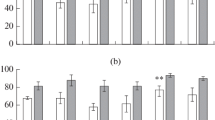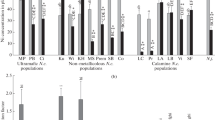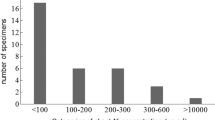Abstract
Experiments were carried out on the tolerance to, and uptake of, nickel by three iberian subspecies of Alyssum serpylliforium Desf. Two of these subspecies, the serpentine-endemic ssp. lusitanicum from Bragança, Portugal and ssp. malacitanum from Málaga, Spain, are hyperaccumulators (> 1000 μg/g in dried material) of nickel. Their possible ancestor, ssp. serpyllifolium (from Granada, Spain) was a non-accumulator of this element. Seeds of the two serpentine-endemics germinated extensively in nickel concentrations up to 12 000 μg/g (1.2%) whereas ssp. serpyllifolium only germinated in nickel concentrations below 60 μg/ml. Tolerance tests involving measurement of new root lengths of excised seedlings placed in varying nickel concentrations, again showed much greater tolerance of the two serpentinophytes. In both series of experiments, the order of tolerance was: ssp. lusitanicum > ssp. malacitanum > ssp. serpyllifolium. In pot trials involving seedlings of ssp. malacitanum grown in mixtures containing varying amounts of calcium, magnesium, and nickel, the most important finding was that plants will tolerate higher nickel contents in the soil when excess calcium is added. This is achieved by lowering the uptake of nickel. There appeared to be some concomitant reduction in calcium uptake in the presence of nickel, and some increase in uptake of magnesium. The resultant lower calcium/magnesium ratio in the plant, though not symptomatic of a favourable condition for colonization of serpentine soils, probably results from a mechanism which renders nickel innocuous to the plant at the expense of calcium uptake. It is suggested that the physiological characters of ssp. lusitanicum and ssp malacitanum are sufficiently different to support arguments for promoting the latter to full specific rank as has now been done for ssp. lusitanicum.
Similar content being viewed by others
References
BrooksR. R., LeeJ., ReevesR. D. & JaffréT., 1977. Detection of nickeliferous rocks by analysis of herbarium specimens of indicator plants. J. geochem. Explor. 7: 49–57.
BrooksR. R. & RadfordC. C., 1978. Nickel accumulation by European species of the genus Alyssum. Proc. r. Soc. Lond. Sec. B 200: 217–224.
GonzalezG. L., 1975. Contribución al estudio floristico y fitosociológico de Sierra Aquas. Acta bot. malacit. 1: 81–205.
HunterJ. G. & VergnanoO., 1953. Trace element toxicities in oat plants. Ann. appl. Biol. 40: 761–777.
KrauseW., 1958. Andere Spezialisten. In: (W.Rühland ed.) Encyclopedia of plant physiology v. 4: pp. 755–806. Springer, Berlin.
LeeJ., ReevesR. D., BrooksR. R. & JaffréT., 1978. The relation between nickel and citric acid in some nickel accumulating plants. Phytochemistry 17: 1033–1035.
Menezes de SequeiraE. M., 1968. Toxicity and movement of heavy metals in serpentinic soils (north-eastern Portugal). Agronomia lusit. 30: 115–154.
MinguzziC. & VergnanoO., 1948. Il contenuto di nichel nelle ceneri di Alyssum bertolonii Desv. Atti Soc. tosc. Sci. nat. Mem. 40: 1–28.
MorrisonR. S., BrooksR. R., ReevesR. D., DudleyT. R. & AkmanY., 1979. Hyperaccumulation of nickel by Alyssum Linnaeus (Cruciferae). Proc. r. Soc. Lond. Sec. B. 203: 387–403.
MorrisonR. S., BrooksR. R. & ReevesR. D., 1980. Nickel uptake by Alyssum species. Plant Sci. Lett. 17: 451–457.
PelosiP., FiorentiniR. & GaloppiniC., 1976. On the nature of nickel compounds in Alyssum bertolonii Desv. II. Agric. biol. Chem. 40: 1641–1642.
Pinto da SilvaA. R., 1970. A flora e a vegetação das áreas ultrabásicas do Nordeste Transmontano. Agronomia lusit. 30: 175–364.
RavenP. H., EvertR. F. & CurtisH., 1976. Biology of plants (2nd ed.), Worth, New York.
TimperleyM. H., BrooksR. R. & PetersonP. J., 1970. The significance of essential and non-essential trace elements in plants in relation to biogeochemical prospecting. J. appl. Ecol. 7: 425–439.
Author information
Authors and Affiliations
Rights and permissions
About this article
Cite this article
Brooks, R.R., Shaw, S. & Marfil, A.A. Some observations on the ecology, metal uptake and nickel tolerance of Alyssum serpyllifolium subspecies from the Iberian peninsula. Vegetatio 45, 183–188 (1981). https://doi.org/10.1007/BF00054673
Accepted:
Issue Date:
DOI: https://doi.org/10.1007/BF00054673




